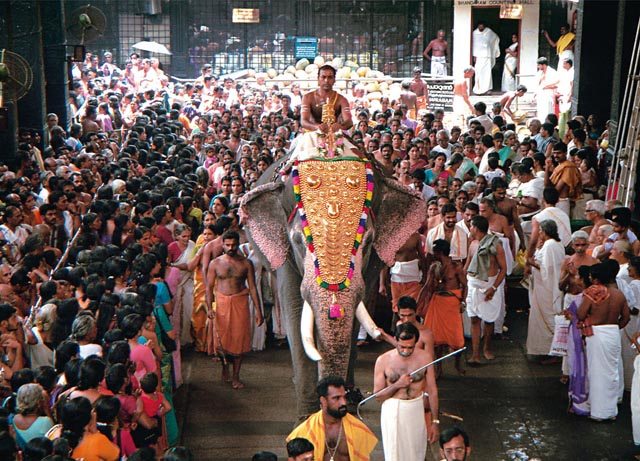
When you finally find Heaven on Earth, it’s hard to leave. Such has been the case of British photographer Pepita Seth who has made Kerala her home, and the iconic Guruvayur Temple the center of her universe.
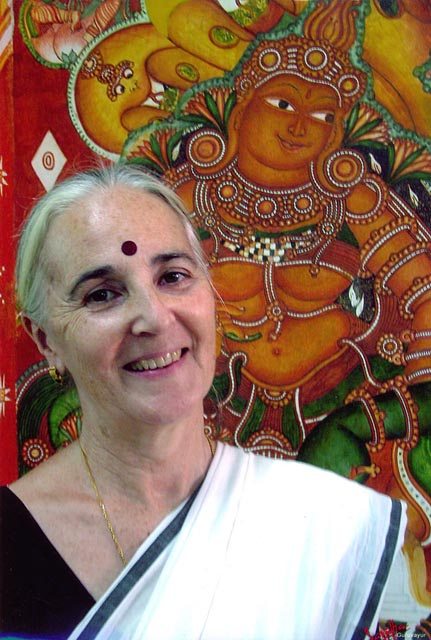
The adventure started back in the 1970’s when she discovered her soldier great-grandfather’s 1857 diary which drew her to explore India. A film maker and photographer, she was fascinated by the rich traditions and culture of Kerala.
In 1994 she wrote a novel ‘The Spirit Land’ and also began an intense research into the Theyyam rituals of Malabar. This led to exhibitions in the US and London about this fascinating lore and a book of photographs.
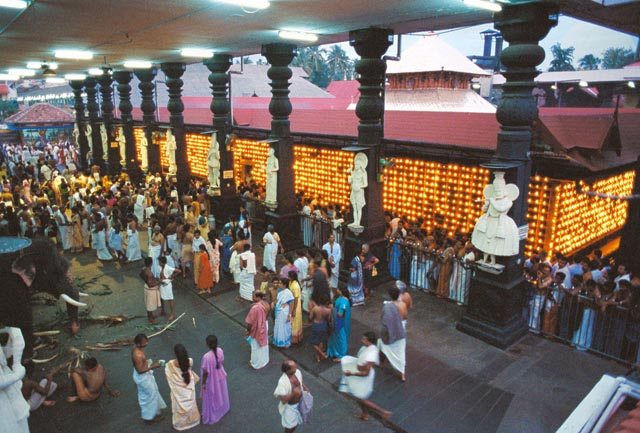
By then, Seth was totally smitten by the beauty of Kerala and actually got permission to research the Guruvayur Temple known as Heaven on Earth. Her painstaking research for seven years led to her new book, ‘Heaven on Earth: The Universe of Kerala’s Guruvayur Temple’. The very fact that she was taken in as an insider is a big compliment for the temple authorities usually do not allow non-Indians to enter the temple.
Recently Seth was in New York at a book reading organized by Indo-American Arts Council (IAAC) at the Aicon Gallery and was interviewed by WNYC reporter Arun Venugopal, who is himself from Kerala and has some happy memories of being blessed by the elephants at the iconic Guruvayur Temple. When asked by Venugopal as to what brought her to the temple and how did she, a non-Indian and a non-Malayalee, get such access, Seth said, “I went to Kerala because I was interested in elephants. I waited and waited and not always knowing I was waiting – somehow one thing led to another.”
The lure of elephants might have brought her to the temple, but over the years her faith in Guruvayurappan grew. Most temples are very strict about access for non-Indians, but Seth had real devotion and staying power. She recalls, “If you’re told no way are you going to be allowed inside you accept it. But I still continued to stand outside.”
Finally the temple authorities were convinced of her devotion and allowed her access to all parts of the temple and even encouraged her to chronicle and photograph the temple. As she says, “I’ve been going there since 1981. I worshiped in the temple before the book and I worship in the temple after the book.”
Most Hindu temples, aside from religious pamphlets, do not have such detailed books about their histories so the publication of the book is a first. For Seth, it has been a labor of love and a responsibility to convey all aspects of this unique temple and its way of life.
No easy task that. She recalls that it took her seven years of intense research to complete the book and a full four and a half years to do a particular chapter, so rich and intricate are the details of this virtual city-state.
To browse through her book of rich text and photographs is to be given a passport into the heart of the temple, to the people who make it shine through their devotion and the customs and traditions which have made it revolve for generations. Seth’s dedication can be seen in the detailed text about rituals and beliefs, festivals and celebrations for Vishnu in the form of his avatar, Krishna, and worshiped as Guruvayurappan. She chronicles the temple’s myth and its history, its traditional management and the many lives which are entwined around it.
Elephants are closely affiliated with the temple and Seth tells the fascinating tale about Gajarajan, the King of Elephants, who was believed to be an incarnation of the Lord. When he died in 1976, Kerala ground to a halt.
“People wept openly, radio stations played solemn music and newspapers were black-bordered,” writes Seth. “Although his tusks were taken to frame the entrance to the temple’s inner compound his body was cremated with high honors and, a year later, a life-sized statue of him was erected near the temple – paid for by public subscription.”
From Heaven on Earth:
The Universe of Kerala’s Guruvayur Temple
Pepita Seth on How the Guruvayur Temple Came into Being
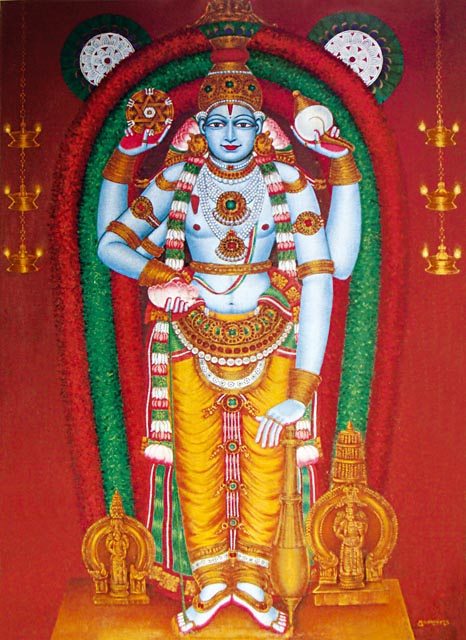
The story of Kerala’s Guruvayur Temple begins with the firm conviction that though the idol now installed in temple was originally worshipped by Vishnu in His heaven of Vaikuntam it was eventually given by Brahma, the Lord of Creation to a couple who used it to pray for the gift of a child. Their prayers were answered when Vishnu appeared before them to declare that they would incarnate three times and that each time He would be born as their son. The child born in the couple’s last incarnation was Krishna who, although He installed the idol in His temple in Dwarka, gave instructions that as soon as He died Brihaspati, the Guru of the Gods, and Vayu, the wind god were to install it in the most holy place on earth. When the time came Guru and Vayu travelled throughout India until they reached a beautiful lake from whose waters Siva emerged to tell them that they were expected and that the place to install the idol was nearby, in a small shrine.
Although Guru and Vayu obeyed Siva’s instructions they hesitated when they reached the shrine and found that it was already occupied by a Goddess. Yet She smiled, reassuring them by declaring that She too was expecting the Lord and would now shift to another place close by. Her only request was that She would continue to be worshiped and that, once a year, the Lord’s main pooja would be done before Her.
A portrait of Lord Guruvayurappan
Whilst symbolism is inherent in every aspect of the temple it has ultimately to be remembered what a temple contains, what it protects and honours and accept that all the rules and mathematical intricacies evaporate once it is understood that the idol is the nucleus at the centre of the whole Universe. Yet though Guruvayur conforms to every ancient concept and the Lord’s idol is the point where all prayers and devotion are directed, it is hard to satisfy curiosity about His appearance. Of course in the eyes of the devotee such intangibilities are meaningless for what he sees is the Lord standing in divine majesty, a smile playing around the corners of His mouth, His raised right hand holding the chakra or discus, the lower one cradling a lotus while the upper left hand displays the conch and the lower one rests on His mace: the classic form of Vishnu in a standing pose.
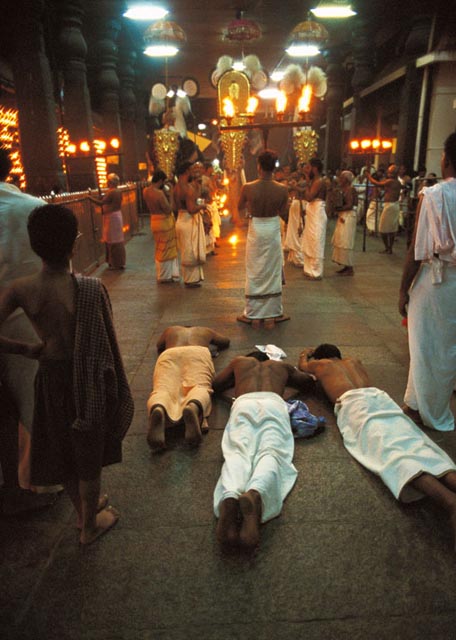
Devotee prostrating during the last night procession
Perhaps the most marked characteristic displayed by Guruvayurappan’s devotees is their very real affection for Him. He is openly loved, without any of the reservations some of the more unpredictable deities often engender. It is the devotees who humanize Guruvayurappan, investing Him with characteristics and traits that bring Him into their lives at a level where He ceases to be a distantly enshrined divinity. They display an intimacy with Him that in no way diminishes their reverence, expressing emotions that speak volumes about their sense of His accessibility and understanding.
All Photos and text by Pepita Seth from ‘Heaven on Earth: The Universe of Guruvayur Temple ‘
Related article: An Evening with Pepita Seth

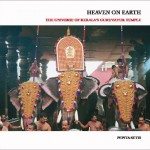
4 Comments
An interesting feature is that this temple has an idol of a standing four-armed Lord Vishnu, made up of a rare kind of stone, worshipped by himself during his 4 avatars!
Hi Maam – I had personal experience with my Guruvayoorappan. He is with me – I can feel it.
Hi Santhosh,
You’re fortunate to have been to Guruvayur. More photos would be in the book ‘Heaven on Earth: The Universe of Kerala’s Guruvayur Temple’. If I manage to get more, I will certainly post them.
I Visited Guruvayur few weeks back. The whole atmosphere was so divine you will feel so peaceful n calm
Procession was just WOW!!
If you have more photos of Procession please post..